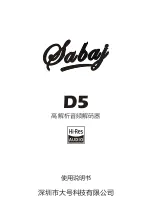
2
Controls:
AC215A: Contrast, brightness,
color, saturation, hue,
horizontal and vertical
positioning;
AC217A: Input selection, output
resolution, input to output
aspect ratio conversion
Input Decoding:
AC215A: 8-bit Y,
8-bit C, and 16-bit YUV with
comb-filter processing;
AC217A: 16-bit YUV with adaptive
4H comb-filter processing
Input Formats:
Normal (4:3),
Letterbox (16:9)
Input Types:
AC215A: Composite and S-Video
(Y/C), both terminating into
75 ohms;
AC217A: Composite, S-Video,
(Y/C), both terminating into
75 ohms, component
Input Video Standards:
AC215A:
NTSC, NTSC-Japan, PAL
(B, D, G, H, I, M, N, N-3.58),
SECAM;
AC217A: NTSC, PAL (B, G, H, I)
Output Resolutions:
AC215A: 640 x 480, 800 x 600,
832 x 624, 852 x 480, 1024 x 768,
1280 x 1024 (60 Hz only);
AC217A: 480p, 720p, 1080p,
1280 x 1024, 1366 x 768
Aspect Ratio Conversion:
AC217A:
4:3 to full screen, 4:3 to 4:3 in 16:9
screen, 16:9 to 16:9
Switch:
AC217A: Selects output
format for RGBHV, RGBS, or
YCBCR
Connectors:
AC215A:
Input: (1) Composite: BNC F;
S-Video: (1) 4-pin mini-DIN
F; Output: (1) HD15 F with
standard VGA pinout,
(5) BNC connectors
configurable as RGBHV,
RGBS, or RGSB (RGB Sync
on Green);
AC217A:
Input: (1) Composite: RCAF;
S-Video: (1) 4-pin mini-DIN
F;
Component: (3) RCAF;
Output: (1) HD15 F standard
VGA pinout;
RS-232 remote:
(1) 3-pin screw terminal
Power:
AC215A: 95 to 250 VAC, 47 to
63 Hz, autosensing, external;
AC217A: 85 to 265 VAC, 47 to
63 Hz, autosensing, internal
Size:
1.5"H x 7.3"W x 8"D
(3.8 x 18.5 x 20.3 cm)
Weight:
AC215A: 3 lb. (1.4 kg);
AC217A: 2 lb. (0.9 kg)
Specifications
Ordering Information
ITEM
CODE
Advanced Video Scaler.............................................AC215A
Intelligent Video Scaler .............................................AC217A
For optimum performance and a 20% savings, order…
VGAVideo Extension Cable
(Specify length, PVC or plenum construction,
and gender when ordering)...............................EVNPS05
Recognize any of these
situations?
• You wait more than 30
minutes to get through to a
vendor’s tech support.
• The so-called “tech” can’t
help you or gives you the
wrong answer.
• You don’t have a purchase
order number and the tech
refuses to help you.
• It’s 9 p.m. and you need help,
but your vendor’s tech
support line is closed.
According to a survey by Data
Communications magazine, 90%
of network managers surveyed
say that getting the technical
support they need is extremely
important when choosing a
vendor. But even though network
managers pay anywhere from 10
to 20% of their overall purchase
price for a basic service and
support contract, the technical
support and service they receive
falls short of their expectations—
and certainly isn’t worth what
they paid.
At Black Box, we guarantee
the best value and the best
support. You can even consult
our Technical Support Experts
before you buy if you need help
selecting just the right component
for your application.
Don’t waste time and
money—call Black Box today.
Why Buy From Black Box? Exceptional Value. Exceptional Tech Support. Period.
T
he Advanced Video Scaler
and Intelligent Video Scaler
convert images from a TV screen
onto a computer monitor, LCD, or
plasma screen. Here’s more
about how they work.
Types of signals.
TV video is defined by either
the NTSC, PAL, or SECAM
standard, which dictates the
number of lines in the picture, how
the color information is defined,
and the speed with which the lines
are painted on the screen (refresh
rate). But within NTSC, PAL, and
SECAM, there are several formats
that meet these standards.
Composite video is most commonly
used, with video information for
red, green, and blue (RGB) and
sync combined into a single signal.
S-Video, which separates the
chrominance (color) from the
luminance and sync information,
provides a superior picture.
AC217A also supports
component video, which carries
the color and brightness portions
of the video signal as separate
signals. This provides superb color
clarity and reduced color bleeding.
How they work.
The Video Scalers will accept
any video source, de-interlace it
with proprietary, advanced motion
compensation, and then intelligent-
ly scale it to the desired resolution
with virtually no artifacts. All you
need to do is set the output resolu-
tion to match the native resolution
of the connected LCD, DLP, or
plasma projector or display.
Technically Speaking
Convert images from your TV screen to clear, crisp images on your
computer screen for superior presentations.
Typical Application




















